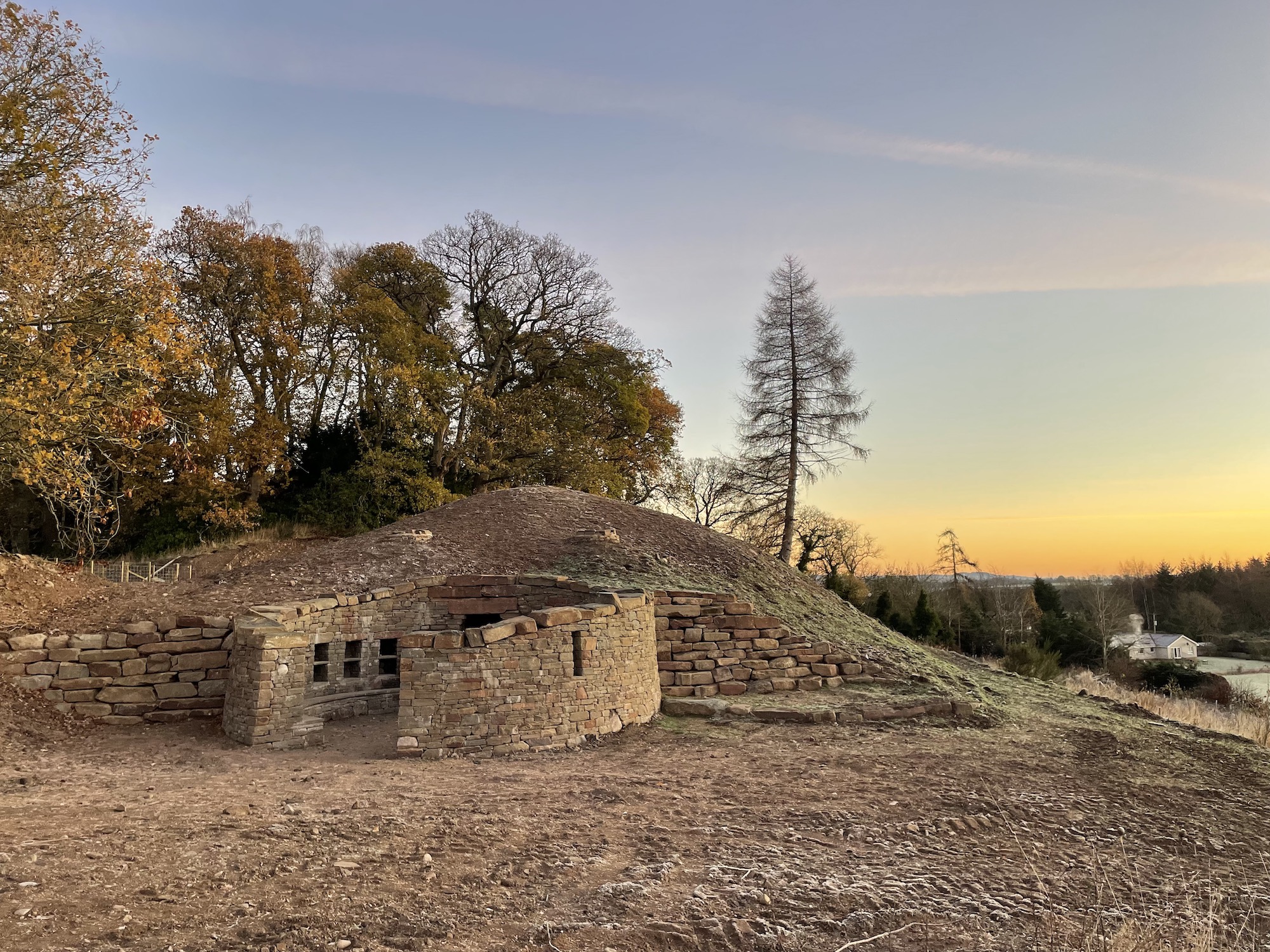The world has never felt so still, so calm and so quiet to me as the evening when I stood inside the central chamber of the long barrow at Fingask Castle in the Braes of the Carse in Scotland. The skies, the darkest tones of obsidian and the stars clustered as if guardians of the moon.
We are taught to fear the dark, perhaps we even fear the night and yet, when I turned my head torch off and looked up through the main oculus, I had the most visceral sense of being alive; an imperceptible sensation in my solar plexus. Underneath my feet, autumn leaves had gathered, windswept into an oval shape.
I’m standing in a structure that’s been built by a small team of men led by seventh generation stonemason, James Davies whose father, Geraint Davies is a master stonemason and designer of long barrows. Each barrow is drawn by hand and in 2014, Geraint completed the long barrow at All Cannings, Wiltshire – thought to be the first Neolithic-style burial mound to be built in the UK for more than 5,000 years. It can be described as a columbarium – with more than 200 niches and, within these, cremated remains can be placed in urns.
All Cannings is owned by Timothy Daw who was a historic property steward at Stonehenge and would often experience grieving relatives wishing to scatter loved ones ashes within this spiritual place. This of course isn’t allowed. He knew people wanted a more natural, less commercial way to remember the dead and a barrow made sense to him.
It was Geraint who persuaded Timothy to build the barrow from stone – dry-stone laid honey-coloured limestone with a Sarsen stone entrance like the one at Stonehenge. It’s now a registered Druidic Place of Worship and those who visit can celebrate Solstices and Equinoxes. There are regular open days throughout the year and visits can be arranged.
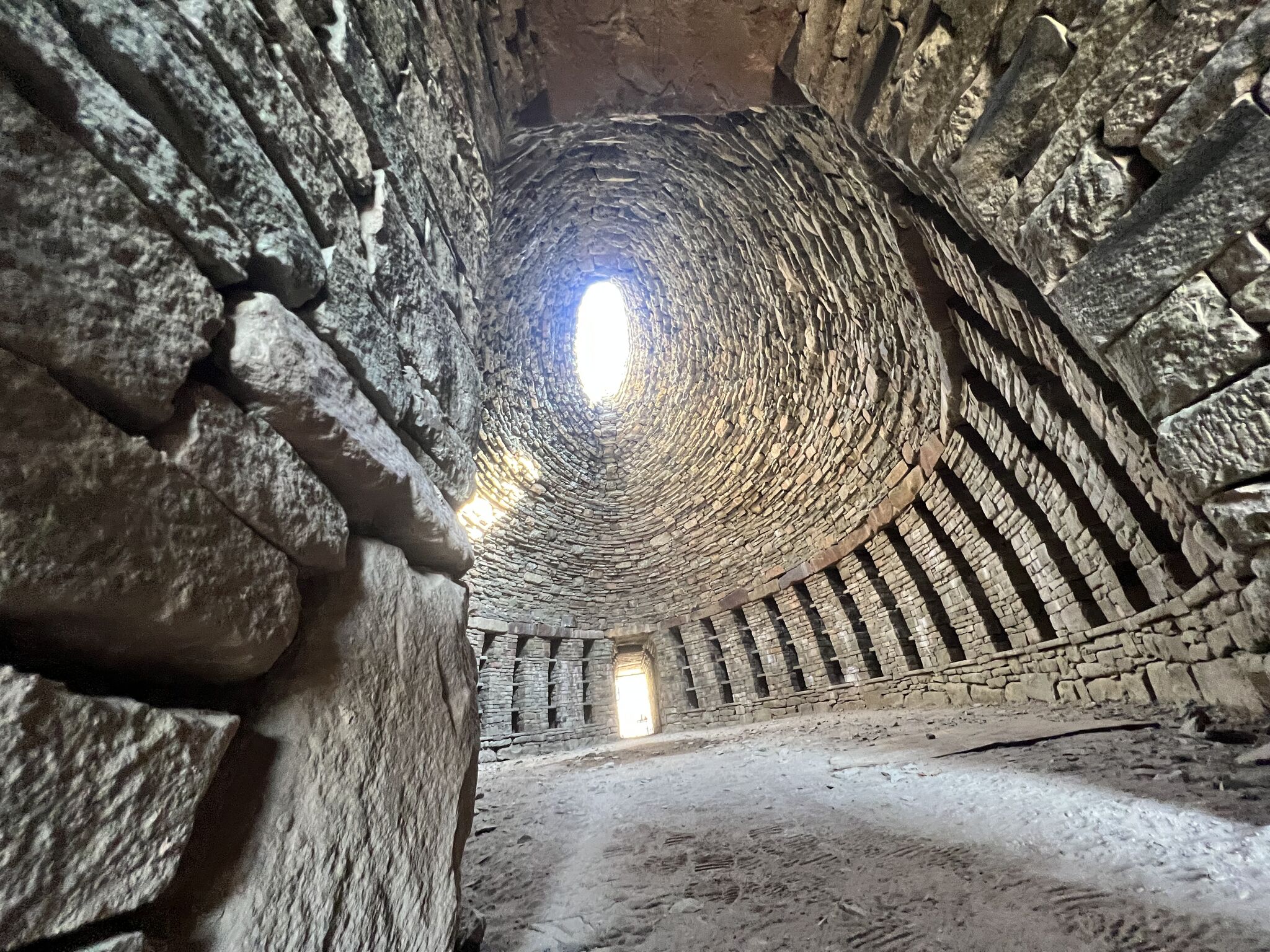
The view of the main chamber in the barrow at Fingask.
Traditional stonemasonry practices and skills are used to construct the barrows. There is no cement or concrete, only a little lime mortar. From what I understand, it is a peaceful and meditative process, especially for Geraint and James. And, as each stone passes from father to son, it forms the next part of the family connection that goes back more than 300 years.
The barrow at Fingask took around 12 months to complete and comprises more than 400 tonnes of Angus sandstone. It features an oval corbelled roof with oculus in the main chamber and four further smaller chambers with oculi. Like All Cannings, there’s more than 200 individual niches.
The team was led by James and included Aaron Wagner, James Voller, Ravi Mistry and Joby Wheatley. All stone was hand dressed on site and the team moved and laid the stone often working until the light faded. It is handcrafted, an unimaginable feat when you consider the scale of it.
Denfind Stone in Monikie, less than 25 miles from Fingask supplied the Angus sandstone in blocks from its own quarry, Pitairlie Quarry for the build. This stone takes around 400 million years to form but it’s travelled across the world notably used on the building including the Vatican and Cologne Cathedral and, closer to home, used in some of Scotland’s most prominent landmarks including Edinburgh Castle.
It was a much-sought after material but production ceased with the advent of WWI and the original quarry closed down. In 2004, Brian and Alison Binnie reopened Pitairlie and added a state of the art processing facility next to the quarry minimising the need for further transportation and keeping the operation as sustainable as possible.
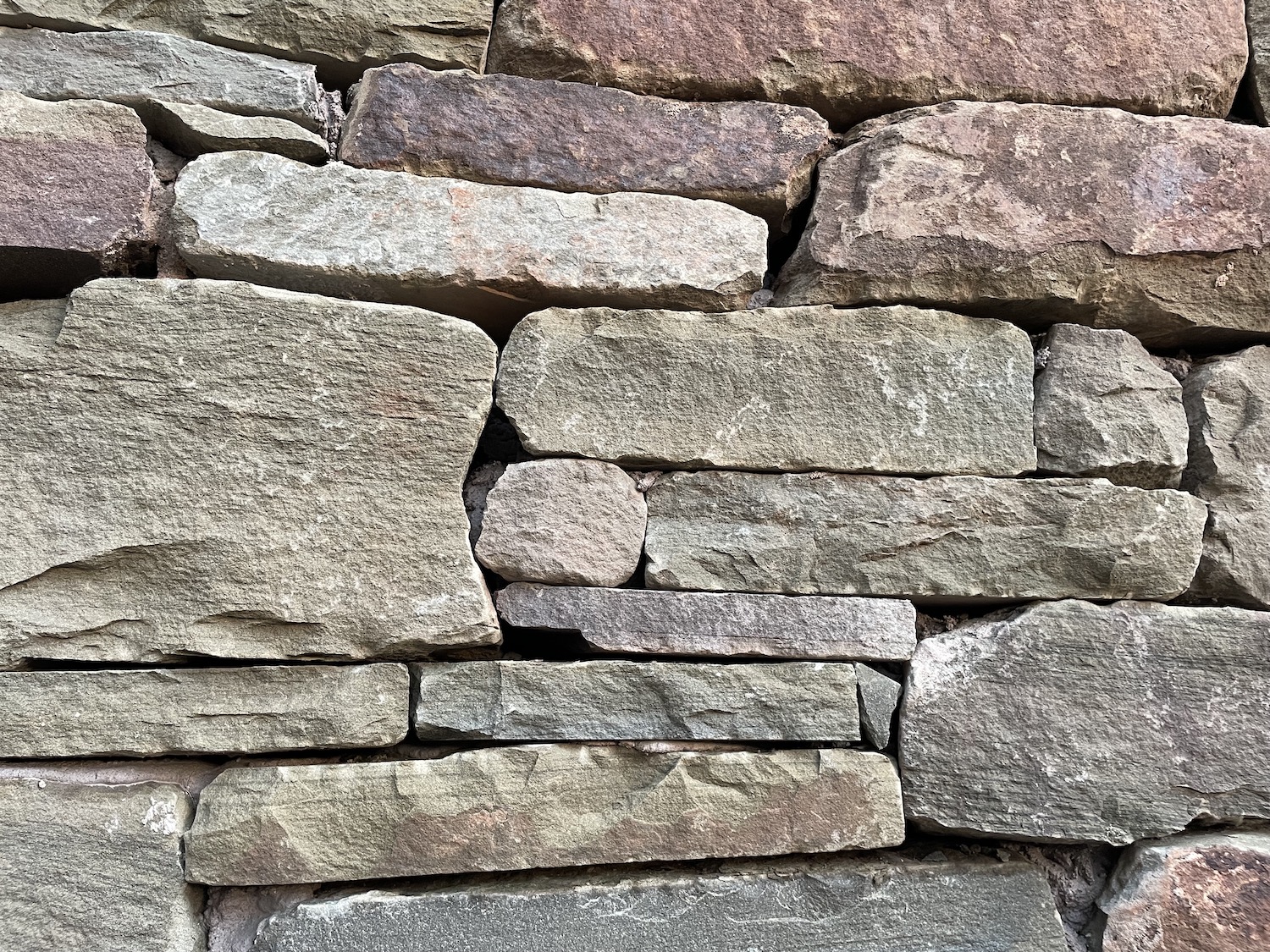
Denfind Stone's Angus sandstone was used throughout the project.
The use of locally quarried stone gives each barrow a sense of place and once complete, these structures are enveloped by the landscape in which they sit. Long barrows are discreet, topped with earth and given over to grass or meadow. There is minimal disturbance to the environment during construction with no noisy machinery being used and, if anything, nature is given a better habitat as a result. Natural stone with its plentiful, beautiful irregularities provides a home for wildlife and when I visited, there were hundreds of insects hiding in the niches including a moth whose tea-stain coloured wings appeared to have been brushed in places with amber. It was likely a Herald. These moths are Scottish natives and often overwinter in ruins and caves, seeking shelter in autumn and emerging in spring. It makes sense that she chose this place to rest.
Look even closer at the individual stones and you’ll spot patterns forming. Each mason has left their own mark and James can tell you exactly who laid which stone. The small stone stacks are the work of Joby Wheatley and James has a favourite stone – it’s much larger and flatter than many of the stones and sits at the back of one of the niches in the main chamber. I can picture it if I close my eyes but I’d struggle to compare the shape to anything I’d seen before.
The owner of Fingask Castle, Andrew Thriepland would describe himself as having ‘barrow mania’ and was considering having a barrow built within his grounds. Geraint was recommended by a mutual friend, Susan Custance and discussions began.
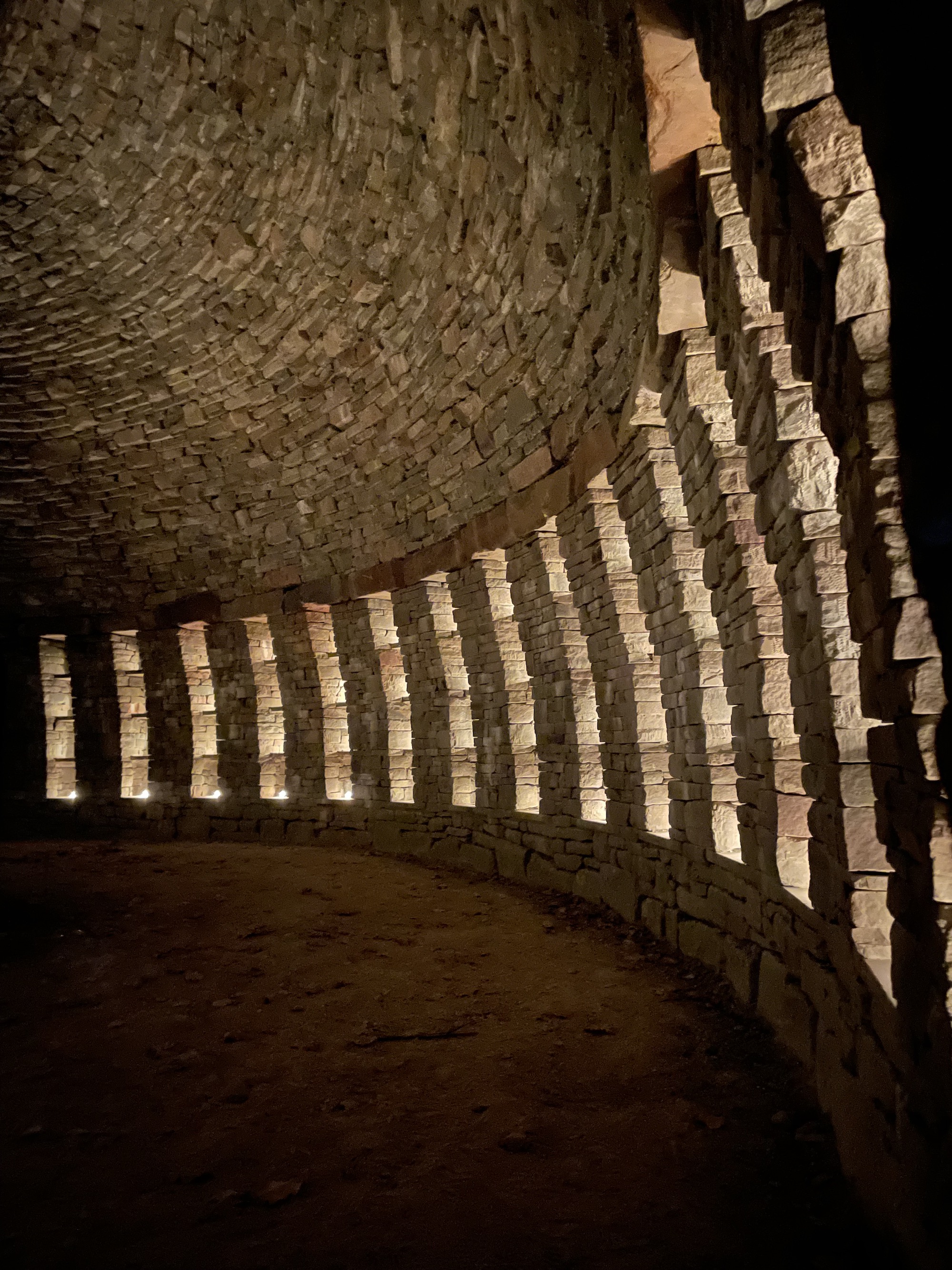
The atmospheric long barrow with niches illuminated by candlelight.
When I visit in late November 2024 on completion of the barrow, James takes me to the castle to meet Andrew who hands me a small stack of papers.
I go to sit opposite Andrew but I’m intrigued by the unusual pottery on the dresser behind him and get up to look and when I finally sit back down, we drink tea, the pages spread out in front of me on the wooden table. Barrows are part of Andrew’s very being and during his childhood, his mother, an archaeologist was employed by the Ministry of Works to complete a survey of barrows in south Wales. In turn, she took Andrew and his brothers along to, ‘hold the other end of the tape measure’ he says.
Andrew’s mother was a student of Sir Robert Eric Mortimer Wheeler, who founded the Institute of Archaeology in London in 1937. I mention this part of the story because Andrew’s mother was, without question, a pioneer and this spirit is alive and well in Andrew – and in Geraint and James. It’s what unites them.
It would be easy for the cynical to think that the barrow at Fingask is just a folly but it is designed to be used in the same way as the barrow at All Cannings – a place for everyday people to store the ashes of loved ones. Niches will be available to purchase and bespoke covers can be created – it’s a sensitive memorial and you don’t need to subscribe to a particular faith to see the beauty in it.
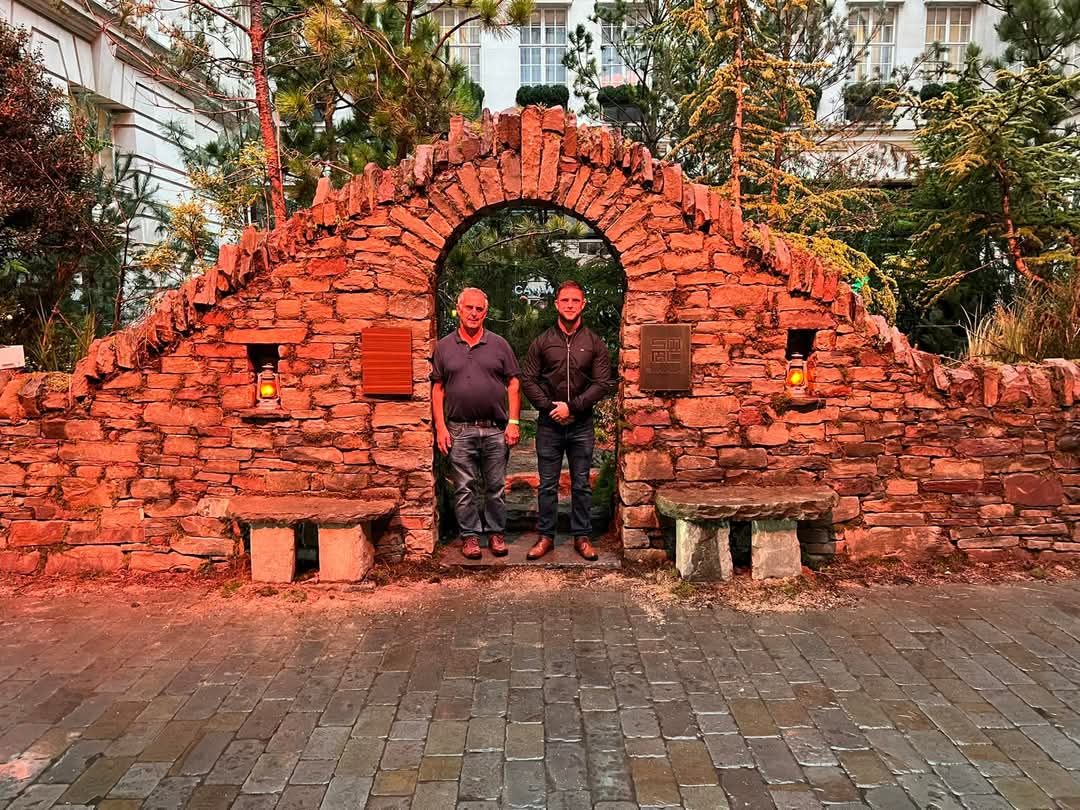
Geraint and James Davies in front of their creation for a Macallan Whisky event at the Rosewood Hotel, London.
When you’re inside a barrow, you’ll feel cocooned and whether you are spiritual or not, there’s something magical there. Barrows go by different names depending on where you are in the world: Kurgans in Siberia; Soros in Greece and yet, so much about them is unknown. When you start to research the origins of them, it’s easy to end up being more confused than resolute about any conclusion you make. Perhaps we aren’t meant to know.
While we need to honour the past for the inspiration it has given us, maybe we focus too much on what was and not what could be.
And if you ever go to Fingask, there is a small stone no bigger than my heart tucked above the entrance of one of the smaller chambers. There's only two people that know where it is – but it's proof that I was there. That I, too, lived.
The principles that apply to barrow design and build can be replicated on a smaller scale and Davies Stone Creations can design and build bespoke garden buildings to encompass outdoor kitchens with built-in pizza ovens, sunken wine cellars, bedroom and even en suite wet rooms. Like the barrows, these buildings require no steel – the oval shape with a corbelled roof means they support themselves.
For more information, visit: https://daviesstonecreations.co.uk

